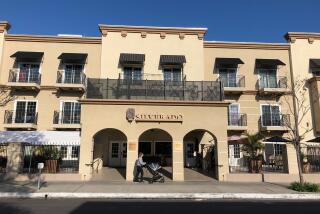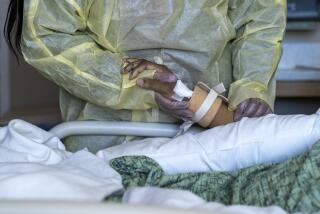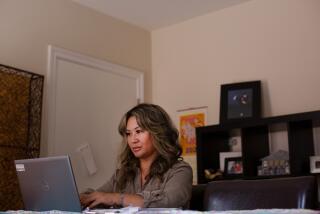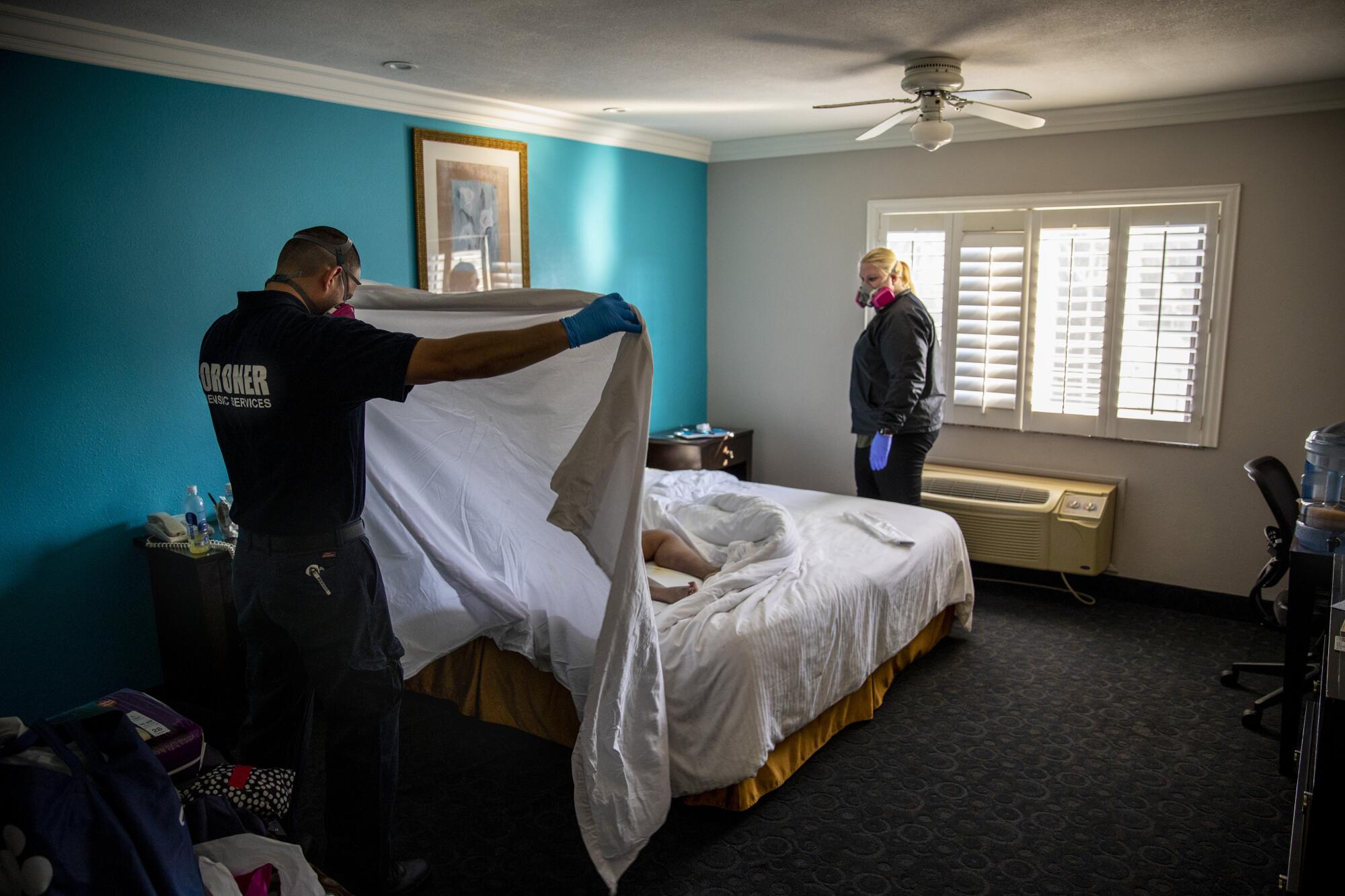
- Share via
Case No. 09567 died alone in an overheated hotel room in West Covina.
She was a surgical tech at Emanate Health Queen of the Valley Hospital. She had tested positive for the coronavirus and was in isolation at the Days Inn by Wyndham on busy East Garvey Avenue South.
She was scheduled to check out Oct. 13, but she never made it down to the lobby. She did not answer her phone or respond to repeated knocking on her door. When the manager let herself into Room 311, she found the 58-year-old lying on the bed. A pillow covered her legs. Her right hand rested on her abdomen. MSNBC played on the television set.
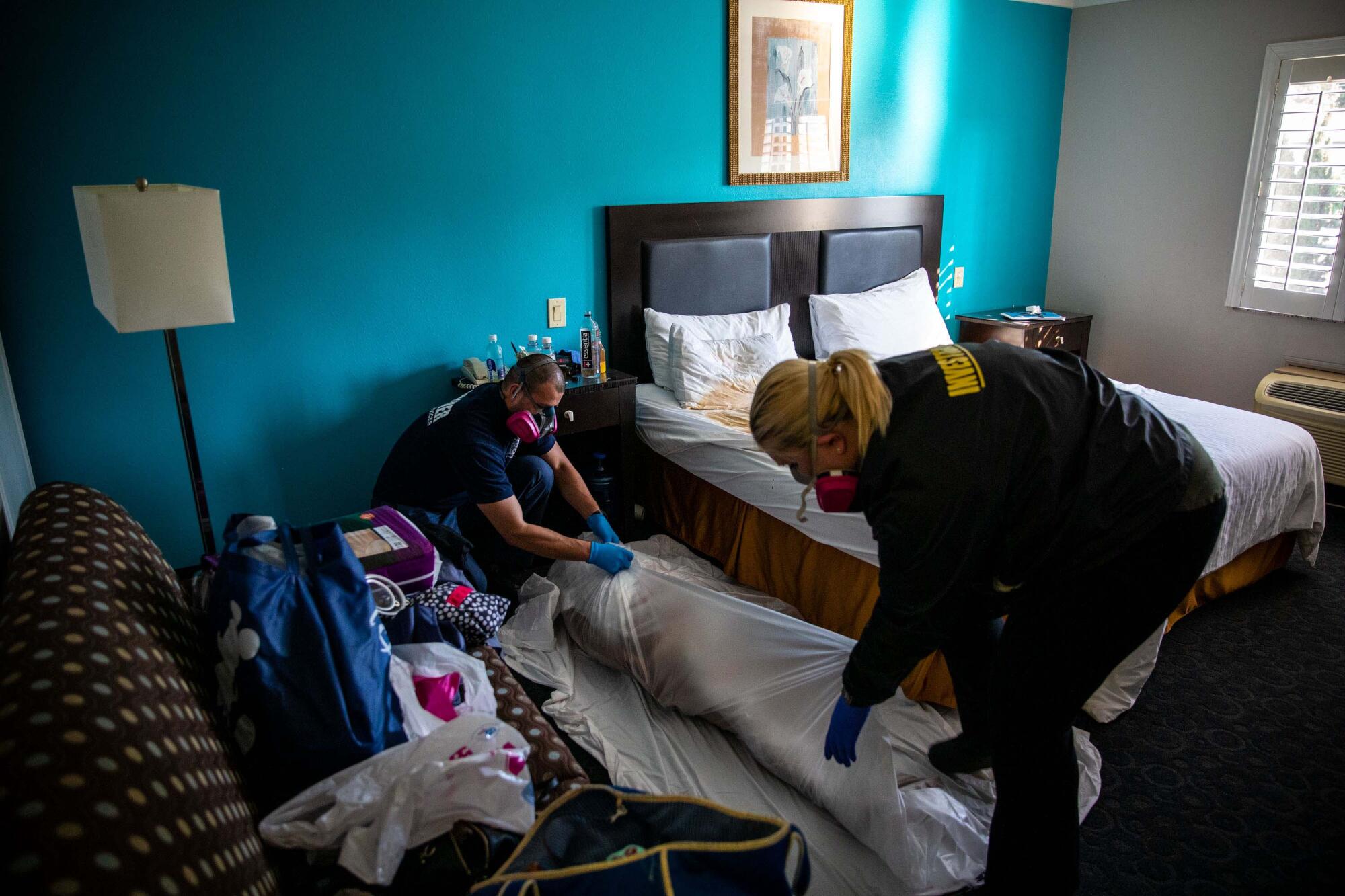
Chouphaphone “Judy” Bounthong had been cleared to return to work that same day, a sweltering Tuesday in the San Gabriel Valley. But she had already begun to decompose.
“She’s probably been here a couple of days,” says Kristina McGuire, as she stands over the lifeless body, noting the dehydration around the dead woman’s lips, how her fingers have begun to mummify and how her chest and the lower half of her face have begun to turn green.
McGuire is an investigator with the Los Angeles County Dept. of Medical Examiner-Coroner. Her job on this day is to piece together the puzzle of Bounthong’s life and death — and to stay healthy.
“I think fewer people are seeing doctors, going to hospitals. … How many people are engaged in healthier behavior versus other coping mechanisms that maybe aren’t healthy?”
— Brian Elias, L.A. County’s chief of coroner investigations
The COVID-19 pandemic, which has killed more than 8,100 people in Los Angeles County alone, has had a dramatic impact on the coroner’s office. But not in the way you might expect.
Yes, investigators and technicians, the people who handle bodies in the field, take extra precautions so as not to contract the virus. But then again, they are always careful, because they never know what they might encounter on a corpse. The coronavirus is one possibility, but there’s also tuberculosis and HIV/AIDS. Some death scenes are contaminated with drugs like fentanyl, which can be inhaled from the air and cause great harm.
The most significant change wrought by the pandemic is in the department’s caseload, which has soared by 20% since the virus began its deadly march through California’s most populous county early in 2020. But most of the increase is not caused by people dying of COVID-19. In fact, it is unclear what has fueled this jump in coroner cases, particularly in drug- and alcohol-related accidents, natural deaths and homicides.
“The pandemic is certainly a big part of it,” says Brian Elias, the county’s chief of coroner investigations. “I think fewer people are seeing doctors, going to hospitals. … How many people are engaged in healthier behavior versus other coping mechanisms that maybe aren’t healthy?”
Elias, however, calls such an explanation “just my conjecture.”
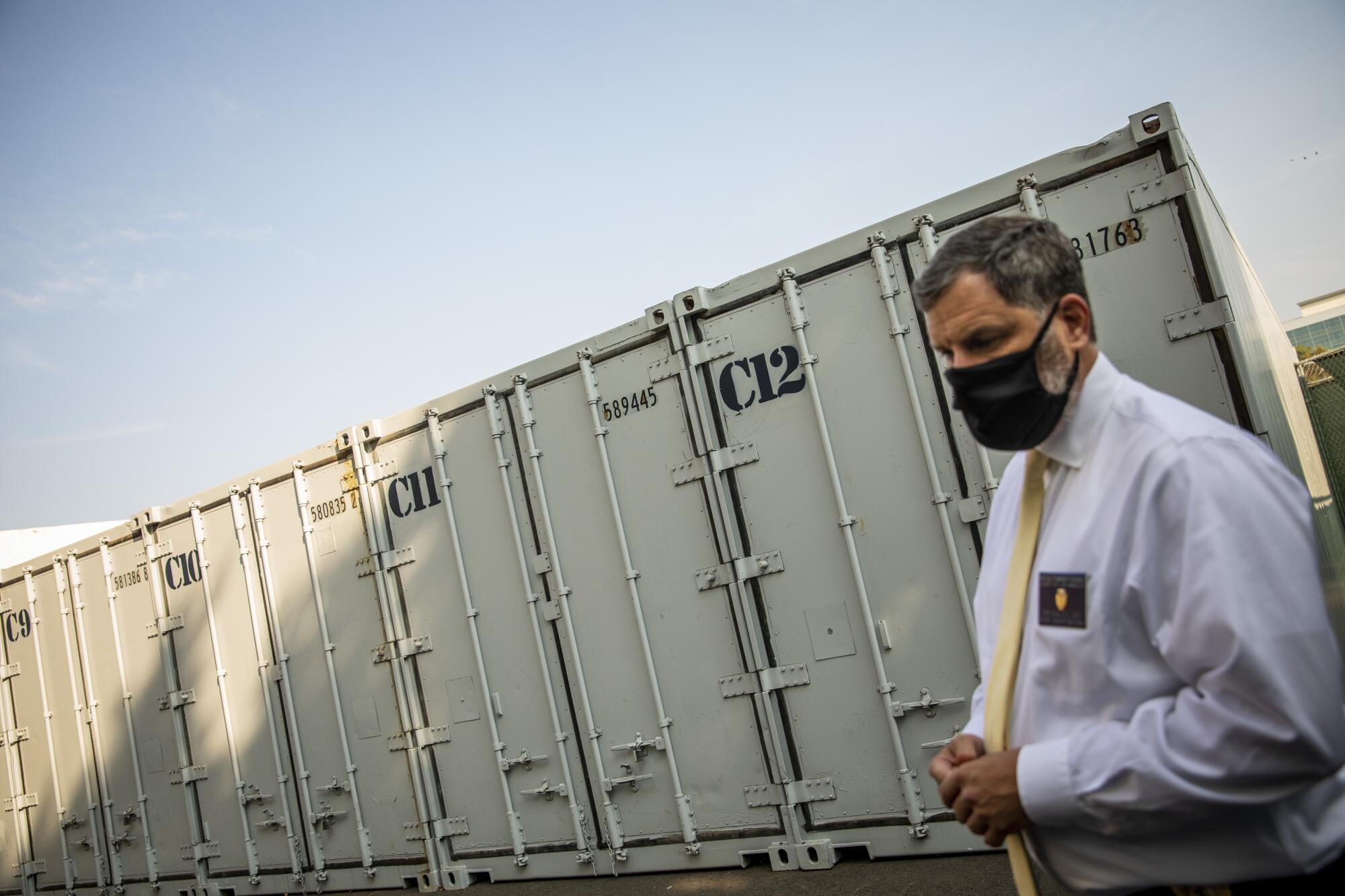
On the day McGuire enters Room 311, it is just one of many mysteries.
::
The motel manager called the West Covina Police Department. Police called the coroner’s office. McGuire arrives on the scene at around 2:30 p.m. and sets to work.
She always gloves up when she goes to a death scene. Her blond hair is scraped into a ponytail. She wears sturdy black shoes that stay in the office when her shift ends at 10 p.m., because, she says, “these come into contact with blood and decomposing bodies. And I don’t touch them with my bare hands.”
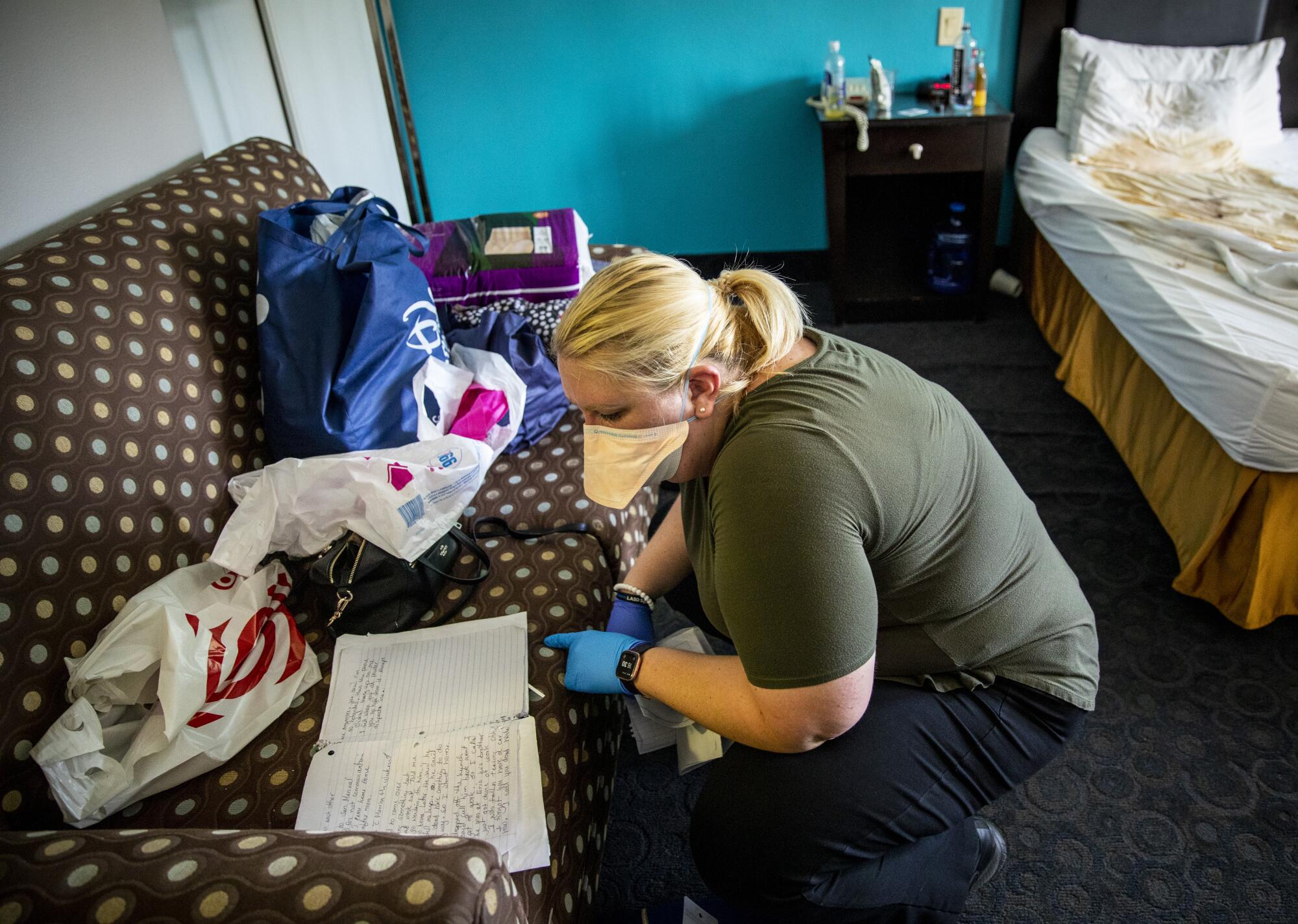
She does not want to bring contamination back to her house in Lancaster. She shares it with her immunocompromised mother, soon to turn 66, who was just diagnosed with cancer for the fourth time.
McGuire knew before entering the cluttered room that Bounthong had tested positive for COVID-19. So her face is obscured by a heavy-duty respirator with big, pink filters, two bright spots in the dim light. Normally she’d wear an N95 mask, but greater comfort means less protection.
Since the pandemic began, she maintains at least six feet of distance from everyone she meets on the job. She is more concerned about contracting the coronavirus from the living than from the dead.
“They still haven’t done studies to determine what’s the likelihood of me catching COVID from a person that’s deceased,” she says, snapping photographs of the room, the dead woman and her belongings. “My jacket goes on when I touch a body, because I don’t want them touching my bare skin. But I’m not in a full Tyvek suit. I know some people who are.”
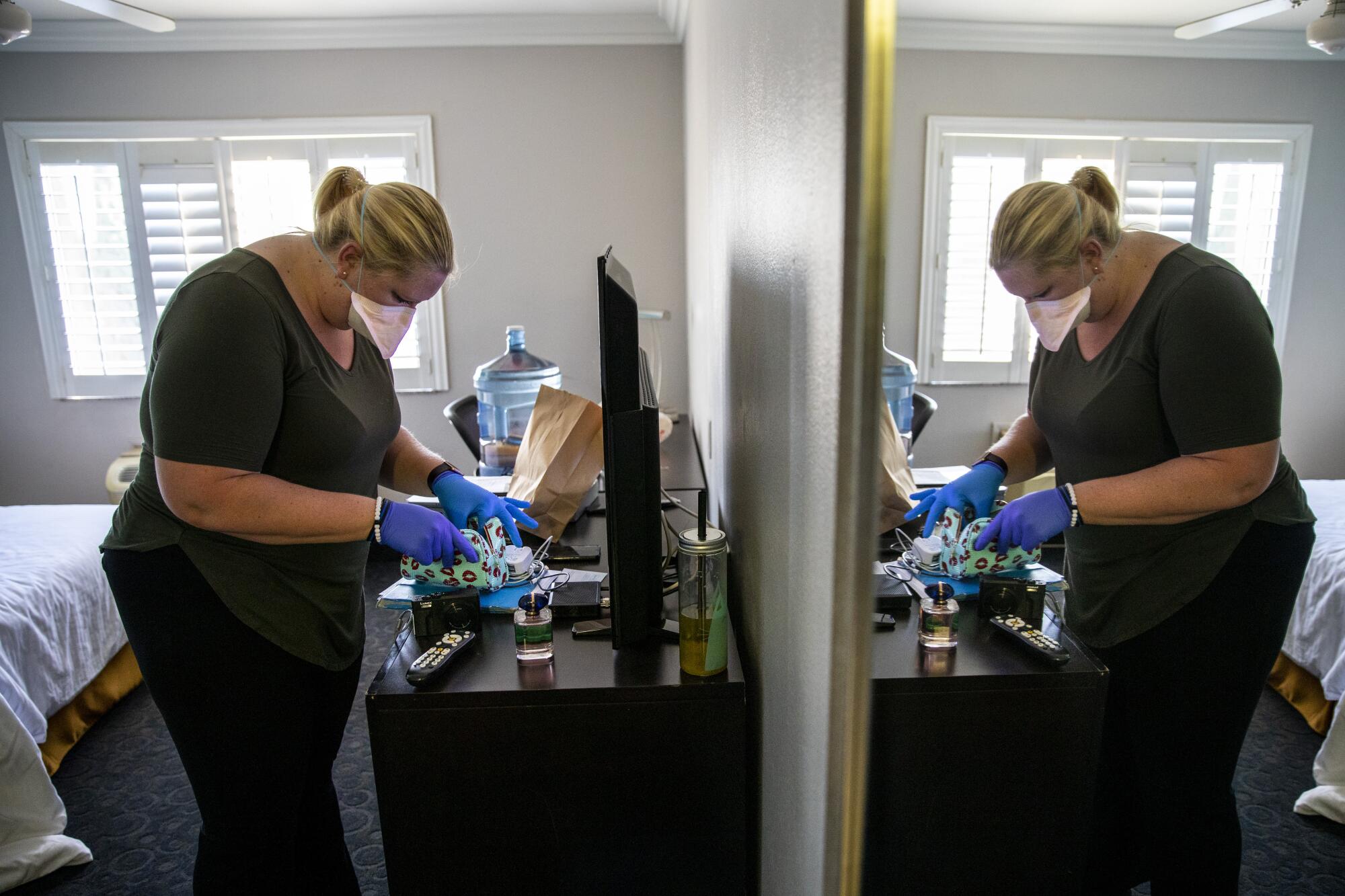
McGuire examines the stuffy motel room, tinged in the afternoon heat with the scent of death. She documents the prescription bottles, the bunch of rotting bananas on the desk, the piles of clothing on the floor, the box of adult diapers.
Every detail adds to Bounthong’s story. Even though medical paperwork at the scene shows she contracted COVID-19, it is not yet certain whether the virus killed her.
“Something looks so simple: 58-year-old nurse found unresponsive in her bedroom after testing positive for COVID,” McGuire says. “Automatically, you go, ‘COVID.’ But I don’t know that. ... I don’t know anything about her. Everything is an assumption, and you find out the truth later.”
At 3:55 p.m., it is time to roll Bounthong’s body over to look for signs of trauma. This is a particularly tricky moment, because when a body is moved, air and droplets of moisture from the lungs can spray out — into the room and onto McGuire and her partner, forensic attendant Jerry Meza.
McGuire puts on her jacket — black with “INVESTIGATOR” in yellow letters on the back — and stands on the bed. With Meza’s help, she rolls the body over. She steps down, changes her gloves, pulls Bounthong’s pink, floral nightgown up with her left hand to expose the dead woman’s back. She snaps photos with the camera in her right.
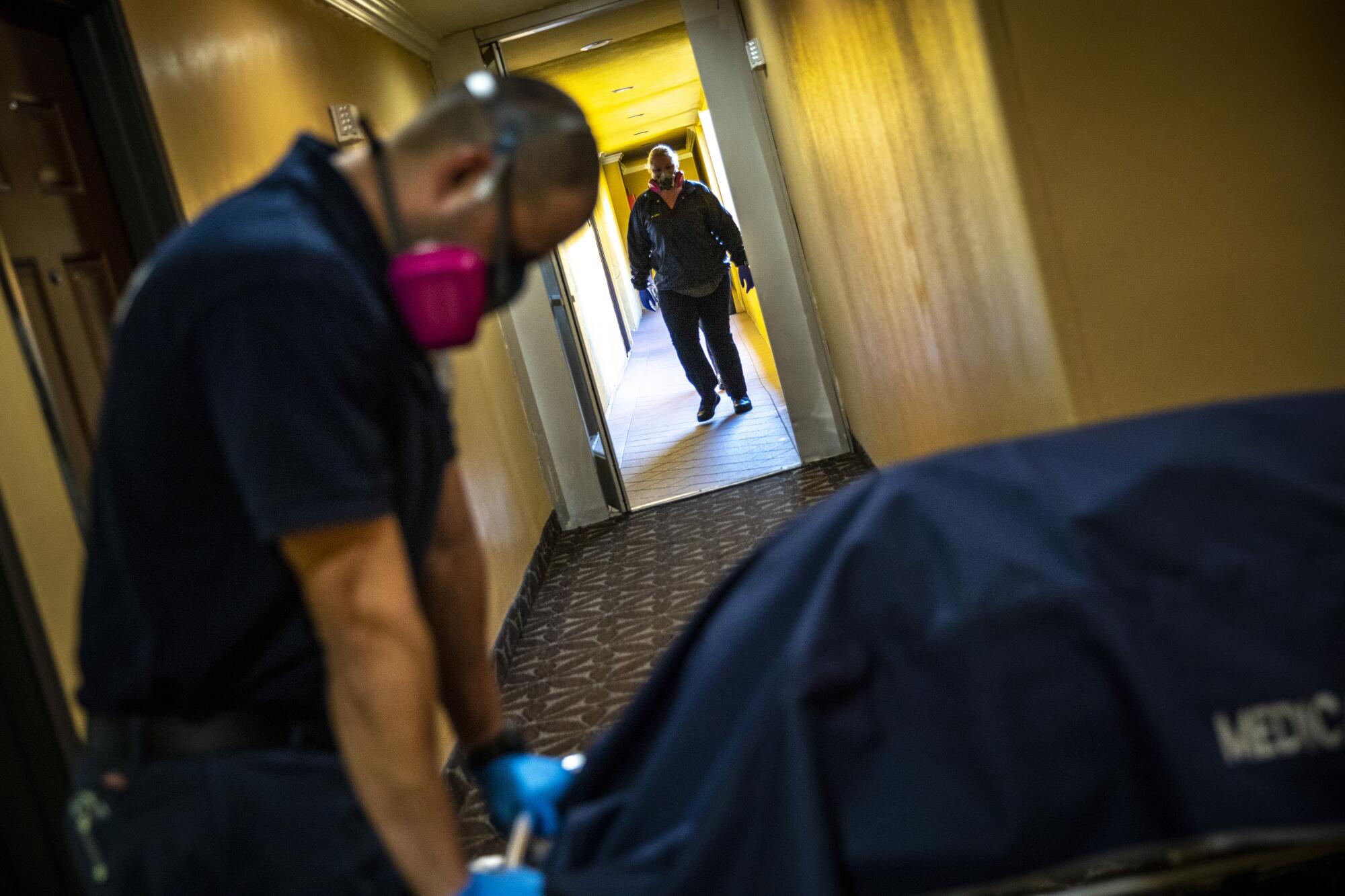
She is careful and gentle. The bed’s white sheets are soiled. Bounthong’s skin is wrinkled in a way not seen on a live person. Her blood has pooled on her back and the backs of her legs, dark and telling. She has been lying there for several days.
“There’s no external signs of trauma,” McGuire says. “I don’t see anything on the back of her head. You can see her lividity, from how she was laying and how she died. I don’t feel any fractures to her skull.”
Meza lays a clean, white sheet on the floor, then places a plastic sheet on top of it. They cover Bounthong’s face with a towel. McGuire takes her feet; Meza, her hands. They ease her off the bed and onto the plastic.
They wrap Bounthong in the protective layers, tie them at her head and feet. Then they lift her onto the gurney and roll her out the door.
::
Karmen Parga holds out her smart phone, and the text conversation with her longtime friend fills the tiny screen.
Friday, Sept. 25:
Parga: Are you okay?? I haven’t seen you all week
Bounthong: Yes I’m okay working extra.
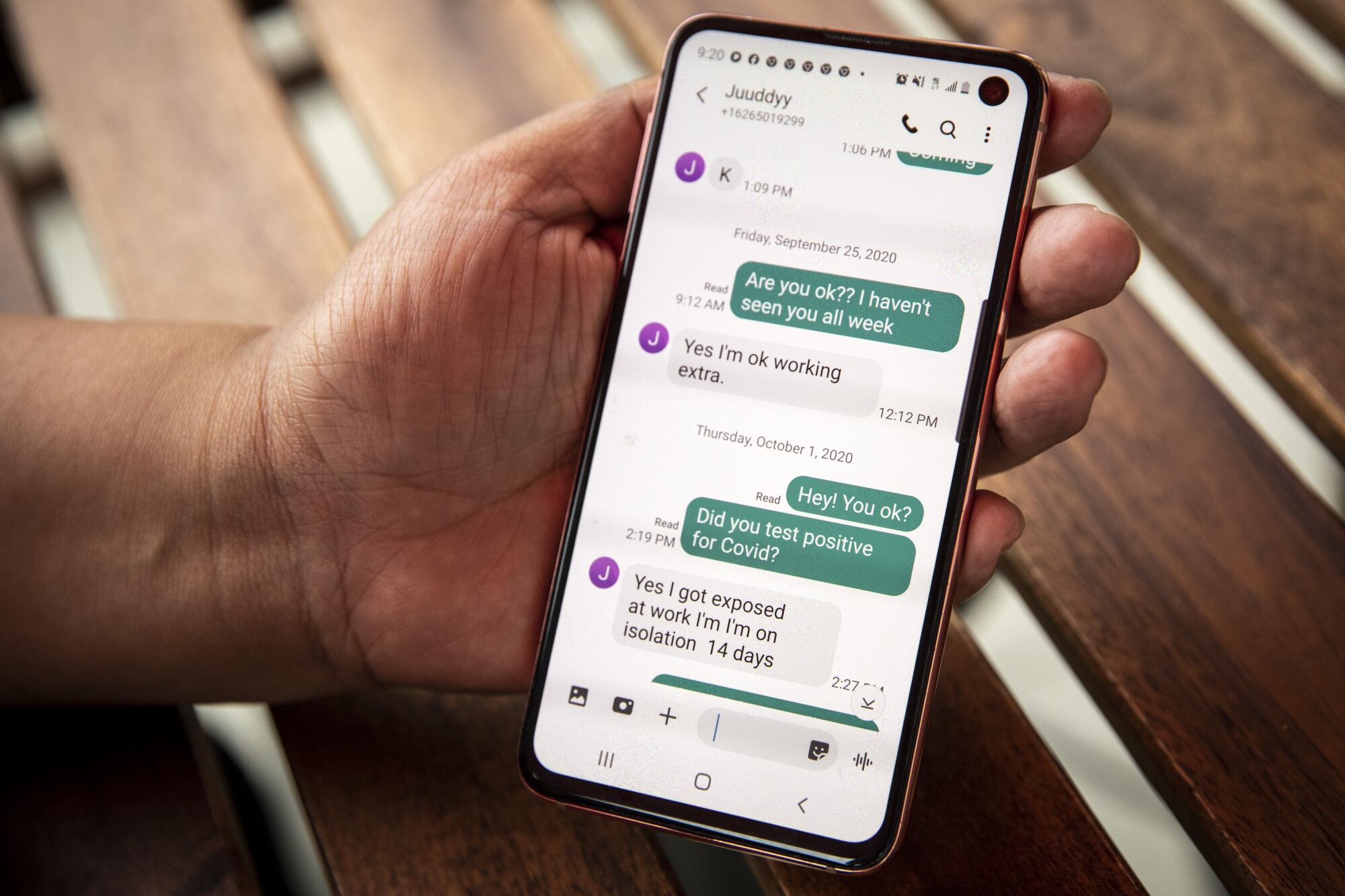
Thursday, Oct. 1:
Parga: Hey! You ok? Did you test positive for Covid?
Bounthong: Yes I got exposed at work I’m I’m on isolation 14 days
The women met nearly 30 years ago while working at a hospital in Paramount. Parga, a scrub tech, lives in Lakewood and describes the tiny Laotian woman as her children’s second mother. They have lived together on three separate occasions, most recently at the time of Bounthong’s death.
Bounthong’s son William, a school social worker, lives near Chicago with his wife, son and daughter. Bounthong’s father died two or three years ago, Parga says, and since then, “Judy had a hard time with depression, with life. ... But she’s always been very caring, very giving. She wants to feed the world.”
She brought food and supplies to the homeless people in the park near her West Covina hospital. She would work 12 hours and race back to Lakewood to make dinner for Parga’s youngest son, Joseph. Each of Parga’s children had a favorite Bounthong specialty: Joseph’s was a spicy seafood soup, Junior’s was sticky rice and mango, Krystal’s was laarb, a meat salad, the unofficial dish of Laos.
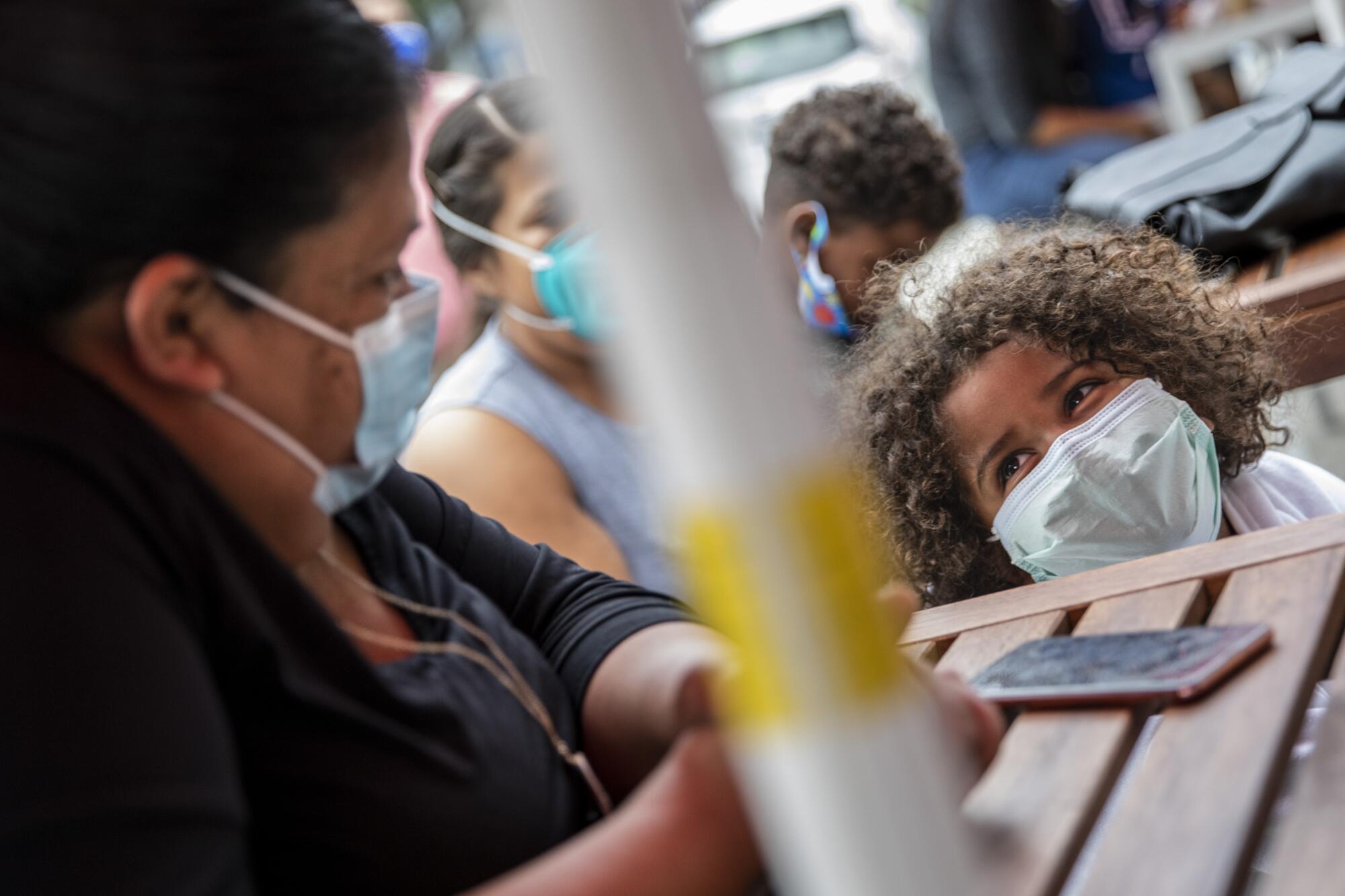
“She would definitely always make sure we were taken care of,” says Parga, who is Latina. “I don’t think she ever made a dish I didn’t like. I don’t think she ever made a dish anyone didn’t like. ... Now we have a pantry full of Thai ingredients I know nothing what to do with.”
Because of the pandemic, Bounthong made sure to change out of her scrubs at the hospital when her shifts ended. She did not want to bring contamination home to her second family. She checked into the Days Inn when she was diagnosed with the virus. The hotel has been a home away from home for healthcare workers throughout the San Gabriel Valley, both healthy and infected.
To William Bounthong, the need for such accommodations during the pandemic “is like the underworld of nursing and COVID.”
“I know when it first started, she was worried about it,” William says. “She felt her immune system was compromised. ... She didn’t go home because she had roommates. That’s why she didn’t quarantine in her own home.”
When McGuire had to inform Bounthong’s family that the surgical tech had died, she dialed Parga.
“The initial shock of her being diagnosed with COVID was so scary,” Parga says. “If I could turn back time, I think I would rather have had her at home. The hardest thing to deal with is that she was isolated for 14 days.”
::
There is no privacy in death — especially when your demise is investigated by the coroner’s office.
Not everyone’s is. About 60,000 people die in Los Angeles County each year. Elias’ staff takes on about 15% of those cases: the violent, the sudden, the unusual. People who die with no known medical history, exposure deaths, homeless people, the unidentified.
In 2019, investigators from the coroner’s office worked 9,668 cases, according to data supplied by the agency. By Nov. 15, 2020, with six weeks left in the year, the caseload had already reached 10,267. If the pace keeps up — and it shows no sign of abating — the department could reach nearly 12,000 cases this year.
The agency’s crypt, where bodies are stored awaiting autopsy or final disposition, holds about 525 bodies; it is beyond full. When the pandemic hit, the department ordered a dozen refrigerated storage containers and five refrigerated trailers, space for another 2,000 bodies. At the end of November, the beginning of the most recent COVID-19 surge, the containers held about 60 bodies.
Drug- and alcohol-related accidental deaths are on track to rise about 15% over 2019; homicides, 29%, according to statistics provided by the coroner’s office. Suicides, however, have not risen, although the pandemic has definitely influenced some of the people who took their own lives in 2020.
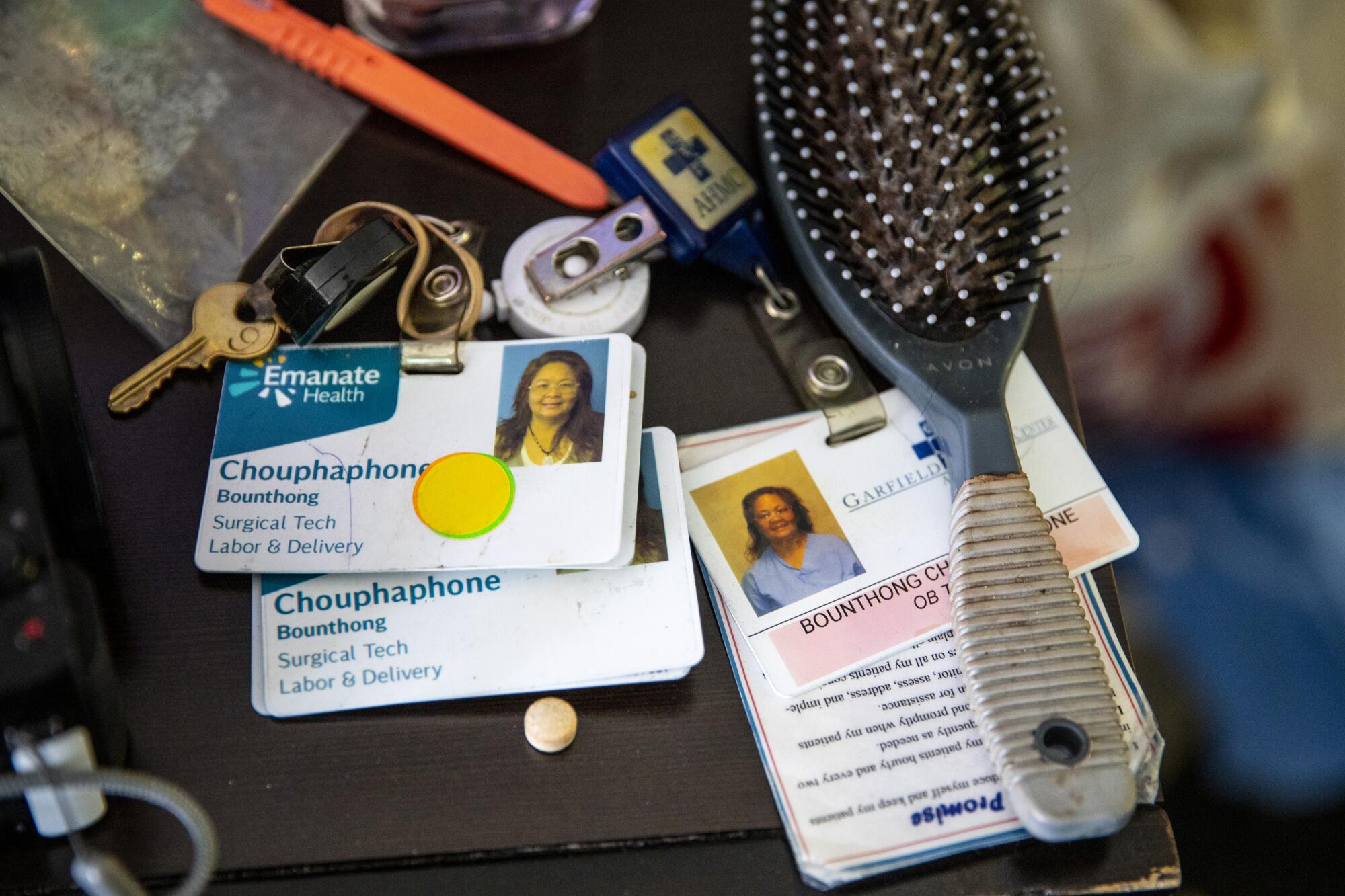
“We do know we’ve had suicides due to, that they directly attribute to, the pandemic,” Elias says. “ ‘I’m isolated. I’ve lost my job. I don’t have those connections I once had.’ ... There’s notes left or this person has communicated these thoughts to others or will send emails, messages, things along those lines.”
McGuire returns to room 311 after she and Meza escort Bounthong’s body down to the white van that will take her back to the office, where she will be examined by a pathologist.
Her face is flushed with heat. Wisps of hair have escaped from her ponytail. Off comes the jacket. With the body gone, McGuire is able to swap the heavy respirator for an N95 mask. She changes gloves again and heads in to examine and inventory Bounthong’s possessions.
Two smart phones. Her work badges. Jewelry. Clothing. A turquoise makeup bag printed with bright-red lips. Black-and-white school pictures of unnamed children. Cash — $131.89 in bills and a splash of coins — spread across the sofa cushion. Pawn slips. Cash-out vouchers from a July trip to a casino.
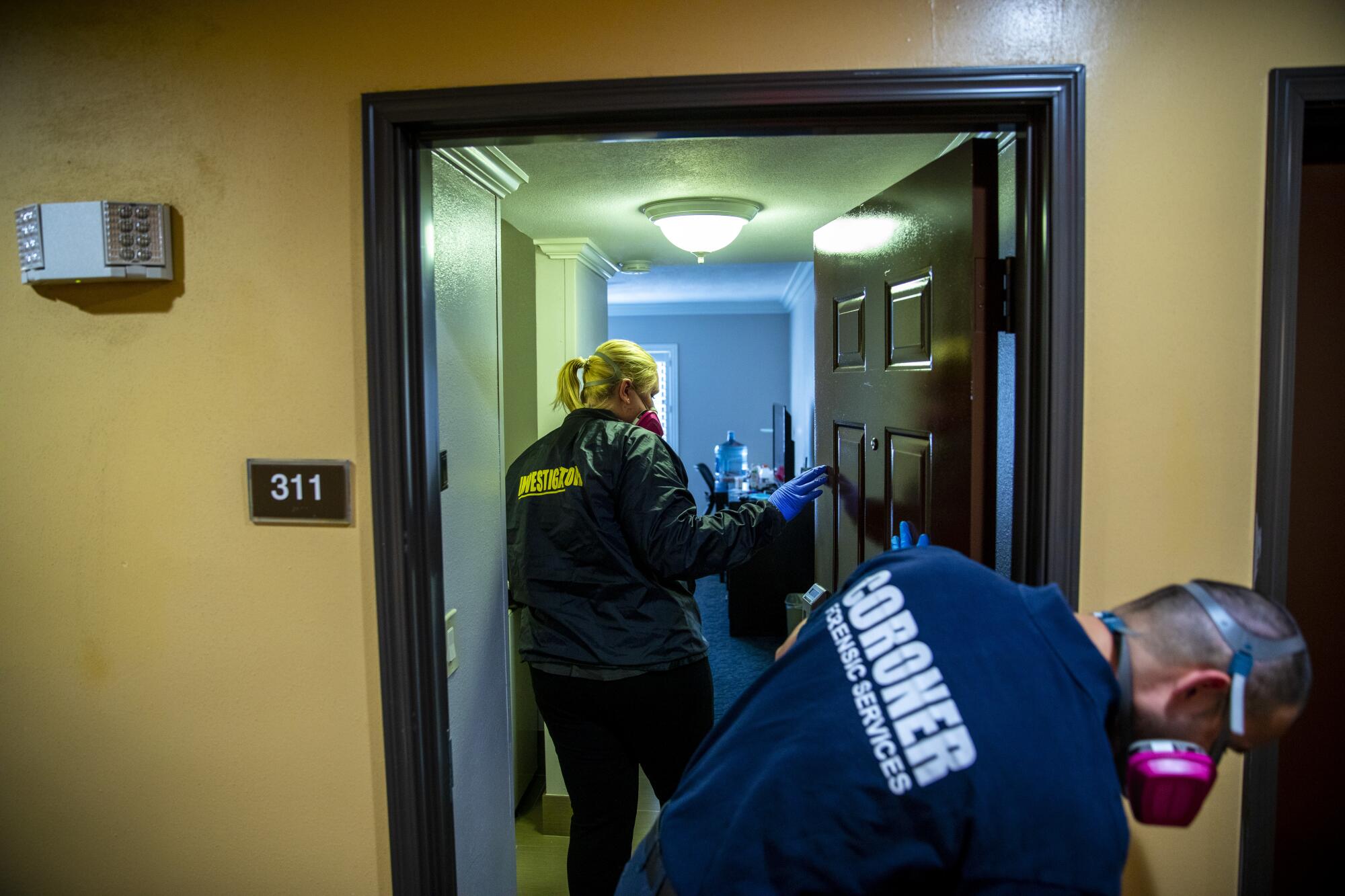
West Covina police Officer Anthony Huacuja, who is working the case, yawns. It’s his last call of the day.
“This is my first call,” McGuire says. “I had a guy light himself on fire yesterday, over by County Hospital. ... I’m assuming he’s got schizophrenia. He was found sitting in a dirt lot, smoldering.”
She goes back to the inventory. There’s a spiral notebook, Bounthong’s journal from months earlier, entries about a relationship gone bad. Nothing about how she picked up the virus.
But there is plenty of evidence that Bounthong was ill. Gatorade and cough syrup and surgical masks. A 5-gallon jug of water. Ibuprofen. A prescription sleep aid; ditto, a muscle relaxant. A baggie, holding a handful of white pills, marked “Anti deppresent Anti Anxiety.”
The investigation has just begun. McGuire will need to find medical records, talk to friends and family. A pathologist will examine the body. That, however, will take time.
When McGuire got to work, there were 103 bodies awaiting autopsy.
By the time she leaves the Days Inn, there are still 70 to go.
Six days after case No. 09567’s body was discovered, at least one mystery was solved.
“This 58-year-old female, Chouphaphone Bounthong,” wrote a deputy medical examiner, “died of COVID-19.”
Times staff writer Ryan Menezes contributed to this report.
More to Read
Sign up for Essential California
The most important California stories and recommendations in your inbox every morning.
You may occasionally receive promotional content from the Los Angeles Times.
